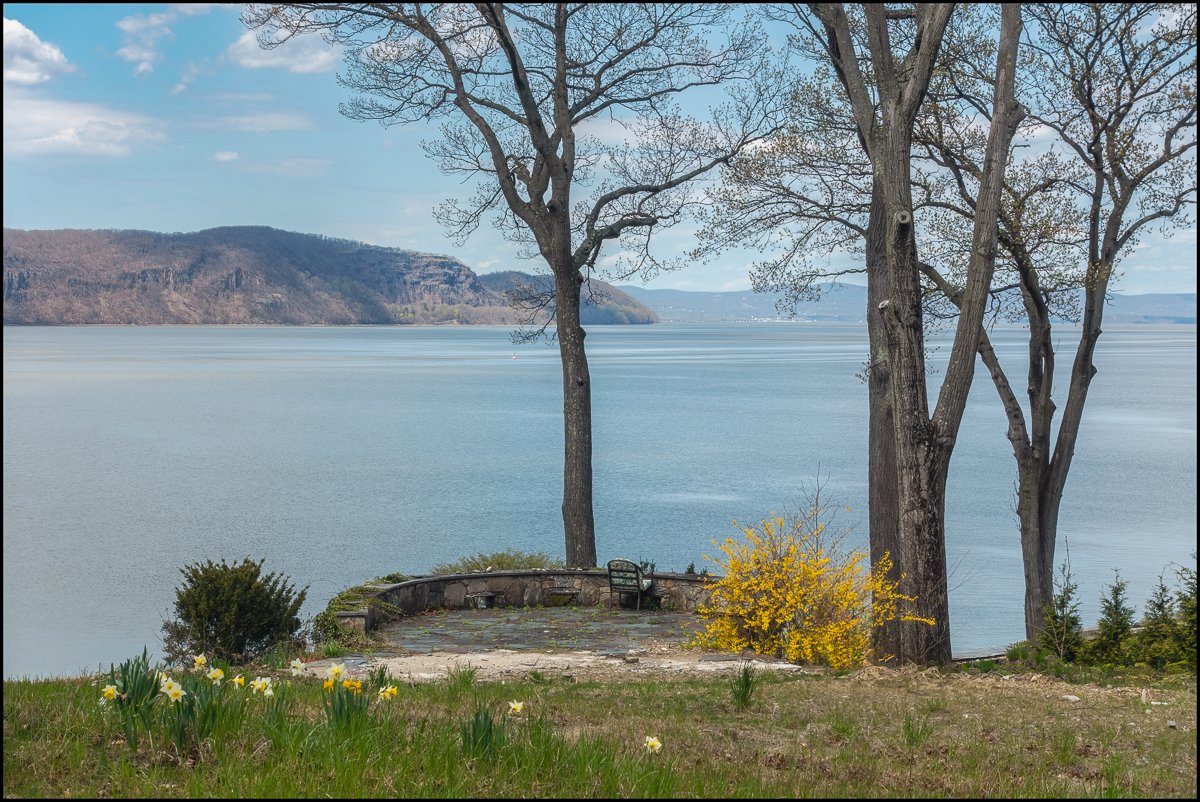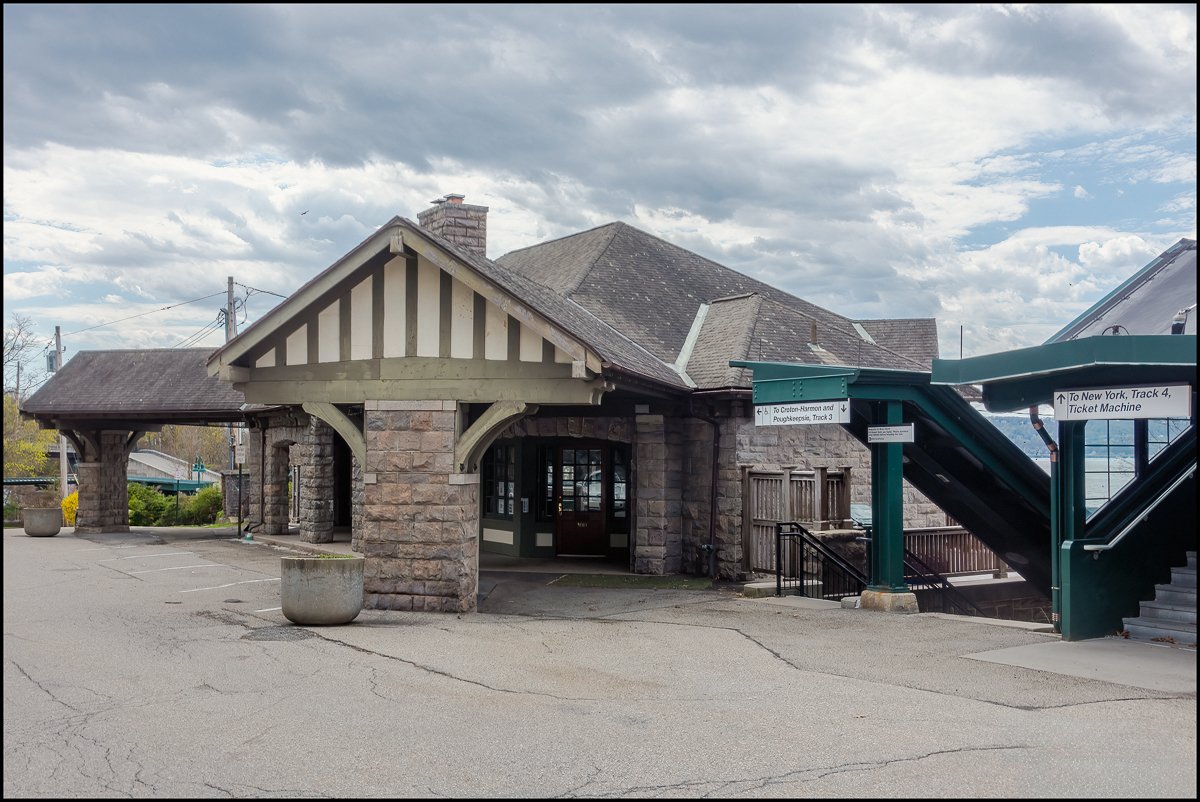From Rockwood Hall to Sleepy Hollow
Overview
A couple of weeks ago I went on another walk. I had recently acquired a new camera: a Polaroid I2 and wanted to try it out (see picture above, one of eight I took. For the rest see: Film Camera 2024 -2: Polaroid I2 – Results). My plan was to go to Rockwood Hall, try out my camera, and try to find a way to walk to Sleepy Hollow/Tarrytown without having to walk along busy Route 9/Albany Post Road. After consulting a couple of maps, I concluded that I could walk from Rockwood Hall, past Kendal-on-Hudson (an assisted living facility with a nice path along the river). I could then walk past Phelps Hospital up to Route 9. From there it was only a short block’s walk along a grass verge adjoining Route 9 to where I could turn onto Hemlock Drive. I could then down to the river and then past Philipse Manor station; through Kingsland Point Park, past the Sleepy Hollow Lighthouse into Beekman Avenue in Sleepy Hollow.
So how did my foray with the Polaroid I2 go.
I was a bit disappointed, but on further consideration I decided that the poor quality of the photographs is most likely the fault of the photographer (i.e. me). One of the main reasons for this is that I’m stubborn. I’d read on a number of websites that the camera didn’t work well in auto mode: i.e. it tended to overexpose and select a slow shutter speed, which introduces blur. I’d been told, but I decided to find out for myself. I can confirm that what the other sites had said was true.
Of course, after I’d scanned them, I had to fiddle around with them in Lightroom. I didn’t want to spend a lot of time on them, so they’re over sharpened in many cases. See the pictures above for how they looked after I’d “processed” them.
There were numerous constraints: Apart from a SX-70 I’d recently used (See: Film Camera 2024 -1: Polaroid SX-70 and Film Camera 2024 -1: Polaroid SX-70 – Results) I’d only ever used a polaroid camera once, and that was about 50 years ago, and it was one of the “cheap and cheerful” models; This was the very first time that I was using this particular camera; I don’t know much about scanning polaroids and I’m not much good at scanning at the best of times; and I’d chosen to use a mode that everything I had read told me not to use.
So, bearing mind the constraints I was satisfied with the results. I’ll certainly use the camera again (I a paid a lot for it), but next time I won’t use the auto mode. Instead, I’ll probably use either Aperture priority (usually my preferred mode) or maybe even full manual.
Along Hemlock Drive
After I’d finished at Rockwood Hall I stayed by the river and made my way past Kendall-on-Hudson; Phelps Hospital; up to Route 9/Albany Post Road and along a very short strech of Route 9 to Hemlock Drive where there were some very nice houses.
Tulips
As I continued my walk I came across a house with a gorgeous tulip garden.
Statues in a garden.
A couple of interesting looking statues seen in a garden while walking along Hemlock Drive in Sleepy Hollow.
Fremont Pond
I then came across this pond. It’s called “Freemont Pond”. The “Freemont” in the name refers to John Charles Frémont also known as “The Pathfinder”. He was an American explorer, military officer, and politician. He was also the first Republican nominee for president of the U.S in 1856 (he lost to Democrat James Buchanan).
A Native of Georgia, he attended college in Charleston until he was expelled for irregular attendance. In the 1840s, he led five expeditions into the western states. Although he opposed slavery, he didn’t seem to have a problem with massacring native Americans, leading the Sacramento River massacre, Klamath Lake massacre, and Sutter Buttes massacre.
He Took control of California from the California Republic in 1846 and was later court-martialed and convicted mutiny and insubordination after a conflict over who was the rightful military governor of California. His sentence was commuted, and he was reinstated by President James K. Polk.
He got rich in the California gold rush and became one of the first two U.S. Senators elected from the new state of California in 1850.
During the Civil War he was given command of the Department of the West by Abraham Lincoln, but when he issued an unauthorized emancipation edict he was relieved of his command for insubordination.
In 1864, the Frémonts purchased an estate in Sleepy Hollow, New York, They named it Pocahoe, ironically a native American name. The house is now a private residence, which still stands at 7 Pokahoe Drive in Sleepy Hollow, a stone’s throw away from where this picture was taken.
After the Civil War, he lost much of his wealth in the unsuccessful Pacific Railroad in 1866, and he lost more in the Panic of 1873.
He served as Governor of the Arizona Territory from 1878 to 1881. After his resignation as governor, he retired from politics and died destitute in New York City in 1890.
Wikipedia has a very long article on him here
A Strange Looking Building.
Here I’m looking across these grasses towards the Hudson River, wondering what this strange building is and what it’s purpose was/is. Then I realized that even though I couldn’t see it, on the other side of the building is the Hudson Line railroad. So I guess it must have something to do with that. I still don’t know what its exact purpose was though.
Some Hudson River Views.
Philipse Manor Station
Next Stop: The Philipse Manor Metro North Station. I’d often seen it from the river side, but I think this was the first time that I had seen it from the other side.
Philipse Manor station is a commuter rail stop on the Metro-North Railroad’s Hudson Line, located in the Philipse Manor area of Sleepy Hollow, New York, United States.
Built around 1910 and opened on January 30, 1911, the Tudorbethan architecture of the station’s original has earned it a listing on the National Register of Historic Places as an intact example of an early commuter rail station. It is the only station on the Hudson Line besides Poughkeepsie to be so recognized. In 1796 the plot of land was used for Rodrigo Curls, a Portuguese immigrant who used the plot of land for fishing, he owned it until the 1830s. This is referenced in documents found in the official website of the Village of Tarrytown.
The construction of the Hudson River Railroad and its later acquisition by the New York Central in the late 19th century opened up the river towns in Westchester County for suburbanization. It became possible for those of sufficient means to live in large houses amid the pastoral and scenic riverside, and accordingly villages like Irvington, Tarrytown and North Tarrytown (today’s Sleepy Hollow) began to grow and develop.Undeveloped areas along the railroad line were soon snapped up by developers who saw the possibilities. In 1900 one, John Brisben Walker, acquired the old Kingsland estate in the north of North Tarrytown and began subdividing it. One of his selling points was the rail access, but this failed to materialize, and Walker had to sell the property, now called Philipse Manor in a confused reference to nearby Philipsburg Manor House, and had to sell to William Bell, who was able to complete it. Construction continued and subdivided land was sold under the name Philipse Manor Company. Bell made the rail service possible by building the station and presenting it to the railroad. Train service began on January 30, 1911.
It remained in use throughout the private ownership of the railroad. When the Metropolitan Transportation Authority assumed passenger commuter operations of the then-bankrupt Penn Central in the early 1970s and passed it along to Metro-North in 1983, it eventually closed the station house in favor of automated ticketing operations, and the main house fell into disrepair. The station has since been reused as the Hudson Valley Writers Center, which won an award from the Preservation League of New York State for its work on the station in 2005.
The main building (no longer used for rail purposes) is a one-story hip-roofed octagonal structure of rock-faced granite block with stone, stucco and wood trim. It is built into the bluff created when the tracks were cut, and thus access to them was provided through the basement, through doors which have since been bricked off.The station’s east facade is augmented with two gabled porte-cocheres projecting at oblique angles, each supported by a heavy granite pier. Trapezoidal wings also jut from the narrow sides of the octagon. The loggia across the facade has central round arched opening with a parapet. This does not lead to an entrance, instead backing the fireplace and its corbeled stone chimney. The original roof used slate, but it has been replaced with asphalt shingles.
Inside, the fireplace uses several colors of granite, flanked with original iron radiators. It is complemented by dark oak matchboards over the stucco, laid to simulate paneling and form a dado. Further ornamentation includes a double frieze at ceiling level. (Adapted from Wikipedia)
The eagle seen in the second picture is one of a number that were once placed on the original Grand Central Terminal.
Kingsland Point Park
Kingsland Point Park is an 18-acre park located on the eastern shore of the Hudson River at the mouth of the Pocantico River in the Village of Sleepy Hollow. With spectacular overlook areas and views of the historic Tarrytown Lighthouse, Kingsland Point Park was one of the first parks developed by the Westchester County Parks Commission.
The park, which was built in 1926, offers picnic areas, ballfields, hiking, fishing and playgrounds.
Above: Approaching the park, old stone bridge over the Pocantio River with just visible Hudson River in the background.
Next three images below: The Kathryn Wasserman Davis River Walk Center. I was last there in November, 2022. For what I said at that time follow the link.
The Kingsland Point Park Pavilion
The Sleepy Hollow RiverWalk
This relatively new public park in Sleepy Hollow provides access to a stretch of Hudson River shoreline that has not been accessible for more than a century! The new park, known as the Sleepy Hollow RiverWalk, hugs the perimeter of the former General Motors Assembly Plant property in the village.
The first phase of the park included paths to provide access along the waterfront from River Street as far north as the historic 1883 Sleepy Hollow lighthouse. A second phase extended the path further north to Kingsland Point Park. These pictures cover the stretch from the lighthouse to Kingsland Point, featuring the mural: The Wishing Wall. According to an article: The Wishing Wall Colors the Sleepy Hollow Community in Westchester Magazine.
A 520-foot community-painted mural brought local residents together during a trying time, thanks largely to the efforts of two area women. Sleepy Hollow’s Kersten Harries knew that a lengthy concrete wall, left after a GM factory closed shop decades ago, could be transformed into something beautiful. As early as 2019, she had been reaching out to owners of the site, Edge-on-Hudson, about turning the space into a temporary art installation. It wasn’t until the summer of 2020 when her dream became a reality, working with Sleepy Hollow community liaison Diane Loja, Edge-on-Hudson, and the Village Board of Trustees to form The Wishing Wall, a mural adjacent to the Tarrytown/Sleepy Hollow Lighthouse, painted by both community members and area artists.
So how did Harries and Loja, project managers for The Wishing Wall, find enough artists to cover a concrete canvas roughly one-tenth of a mile long? “A Call for Artists was used to select a core team of designers [Erin Carney, Tim Grajek, Katie Reidy], who utilized the community’s ideas to create a cohesive design concept that was laid out along the entire wall, which also included locating spots where selected volunteer artists and groups could directly paint their submitted ideas,” explains Harries. “An additional eight artists and community art educators were part of the core team responsible for executing the painting of the mural, with the help of many volunteers who signed up.”
This article, written in 2021 states: “…the wall is slated to come down in 2022”. Well, it’s now mid 2024 and it’s still there. I hope it stays. I like it.
According to Hudson River Lighthouses:
The Sleepy Hollow Lighthouse is unique among Hudson River lighthouses – it is the only “sparkplug” style lighthouse to contain family quarters. Unlike Jeffrey’s Hook, which is essentially a cast iron housing for a staircase, Sleepy Hollow’s brick-lined walls held five floors of living space. The first and largest floor contained the kitchen, dining room, and living room. The second and third floors contained one large bedroom apiece. The fourth floor contained a smaller bedroom and a work room. The fifth floor, which had no windows, just small portholes, was the watch room, where the keeper could keep an eye on the river during storms and other weather, safely out of the wind and wet and out of the way of the light. Another unique feature of the Sleepy Hollow light is the glass inserts laid into the floor of the tower room, which allowed natural light from the tower’s 360 degree windows down into the watch room. Originally a fixed red light, in 1902 the lighthouse was updated to a white, rotating light.
Constructed in 1883, the cast iron caisson was pre-fabricated, as was the trend at that time. The need for a lighthouse off the coast of that section of Westchester County became apparent as early as the 1840s, when pole lights were all that warned mariners away from the dangerous shoals. When the Federal Government started seeking land to purchase to construct a lighthouse, they first looked to Ossining (then known as Sing Sing), but the landowner got wind of the impending sale and the amount he asked for was too much for the government’s budget. The same thing happened again when looking for land near Tarrytown. Eventually, it was decided to locate the island a half mile offshore of Kingsland Point, neatly solving the dilemma of purchasing land.
In the 1940s the interior of the lighthouse was updated with modern sanitation and electricity. The light was automated in 1955, and with the completion of the Tappan Zee Bridge just to the south in 1957, the keeper became unnecessary. Soon, even the automated light was deactivated, in 1961. The lights of the bridge proved to be ample navigation aid for mariners.
In addition, in 1959, the Federal government declared all but one hundred feet of land around the lighthouse to be “surplus” property available for sale. Never mind the fact that the “land” was underwater. It was quickly purchased by the nearby General Motors Plant, who raised that “land” with fill to expand their operations, leaving the Sleepy Hollow Lighthouse, formerly a half mile off shore, within 100 feet of the shoreline. In the 1970s, Westchester County secured an easement from General Motors to build a pedestrian walkway out to the lighthouse, which was completed in 1975. Today, the lighthouse is managed by the Village of Sleepy Hollow Recreation & Parks Department and is considered part of the Kingsland Point Park.
Lunch at the Bridge View Tavern
It was a rather warm day and after walking for some time I was tired; my feet were sore, and I was thirsty and very hungry. My walk had taken me to the bottom of Beekman Ave. in Sleepy Hollow just a block or two from one of my favorite hangouts: The Bridge View Tavern. It has a good selection of beers, food which is decent if not spectacular (fairly typical put style food in fact), a cozy atmosphere and a nice view across the Hudson to the Tappan Zee Bridge. I found myself wondering, however how long the view would last. The restaurant overlooks a former General Motors Assembly Plant. When that facility was demolished in 1999, it left the River View Tavern with a broad, unobstructed view of the bridge. However, the site is now being developed and buildings (condominiums) are popping up all over it. I imagine it won’t be too long before you can’t see the river at all.
From there, refreshed if a little sleepy, I headed home.





































